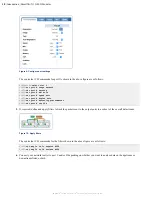
SmartNA-X 1G/10G Modular | Introduction |
13
SmartNA-X
™
1G/10G User Guide 1.4
©
2015 Network Critical Solutions Limited
System Management
SmartNA-X can be managed from a web browser or from a command line interface (CLI). System management can
be performed using a Java enabled web browser, using a terminal client over SSH, or by a direct serial connection to a
terminal or a PC running terminal emulator software.
Configuration options
The SmartNA-X system contains an integrated HTTP web agent that allows you to configure system settings in an
intuitive, graphical user-interface using a web browser from any remotely connected computer. The system also contains a
command line interface that lets you configure the system using SmartNA-X commands, either remotely or direct from a
PC connected serially.
In addition to the web and CLI interfaces, SmartNA-X contains an SNMP agent that allows the system to be managed
from SNMP stations, and SNMP hosts to receive notifications when alerts requiring administrator assistance occur.
Using the integrated management interfaces, you can:
• Display system information and port statistics.
• Configure the network interface.
• Administer local users.
• Change port settings and set up port maps.
• Add RADIUS/ servers for centralized authentication and accounting.
• Add packet filters to maps.
• Set up load balancing groups (supported systems only).
• Update system firmware.
• Configure SNMPv1/v2c/v3 management stations and enable SNMP notifications.
About network TAPs
A network TAP provides a means of unobtrusively connecting to a data network for the purpose of accessing the traffic
(data packets) flowing along that network and sending it to network tools.
Packets entering the TAP can be analysed, blocked, reformatted, or saved to disk, depending on the functionality of the
network tool.
A TAP consists of at least three ports:
• Two data ports that are connected to the upstream and downstream links of a live network.
• One monitor port that is connected to a network tool.
TAPs are commonly used for network intrusion detection systems, VoIP recording, network probes, RMON probes,
packet sniffers, and other monitoring and collection devices and software that require access to a network segment. And
are often deployed on critical network paths where data needs to be continuously monitored. With advanced network TAP
devices like those from Network Critical, 10G sections can be tapped and filtered so existing 1G tools can be used.
Suitable locations for tapping a network
Selecting a suitable network location and scheduling a maintenance window is crucial if you want to avoid missing vital
packets and disrupting the network while you set up the TAP.
There are many places where you can place a network TAP, including:














































